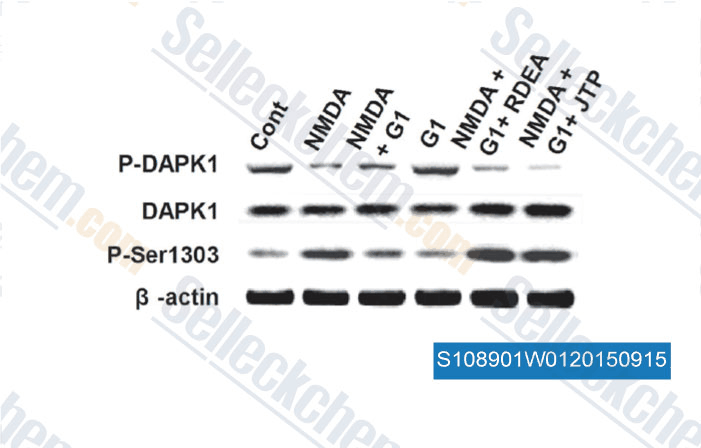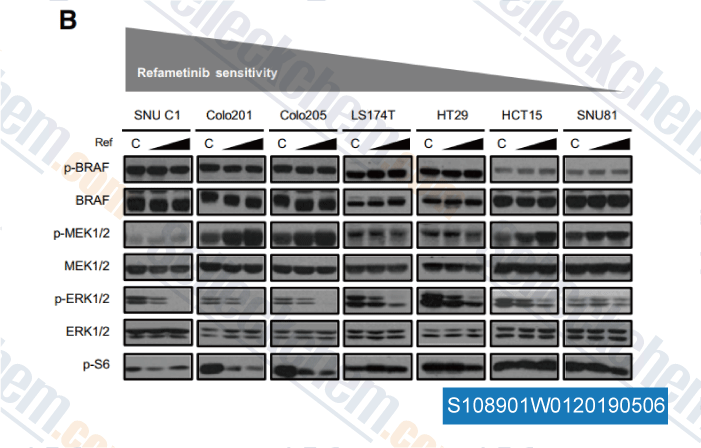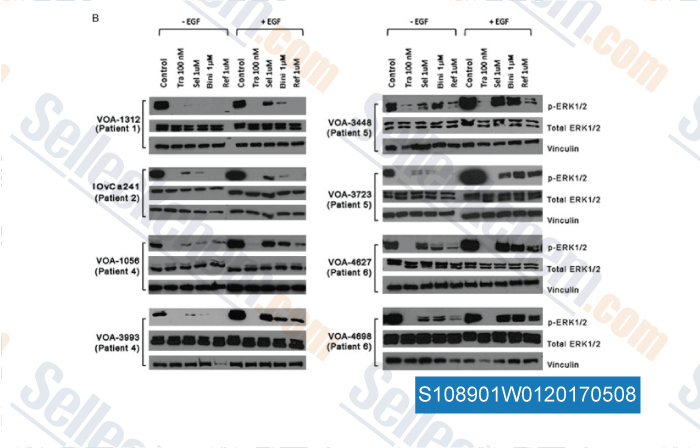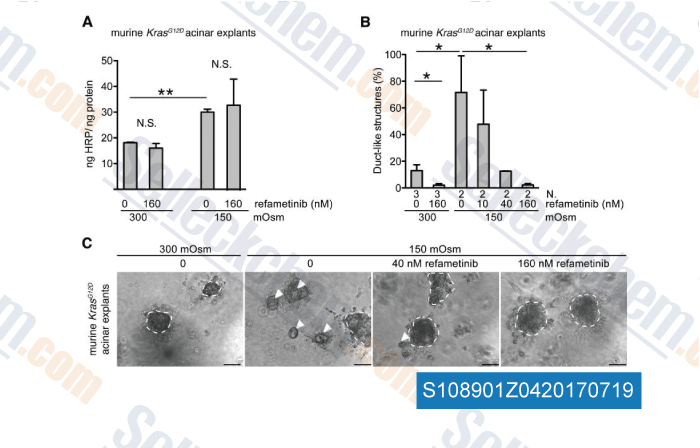|
How to Cite 1. For In-Text Citation (Materials & Methods): 2. For Key Resources Table: |
||
|
Toll Free: (877) 796-6397 -- USA and Canada only -- |
Fax: +1-832-582-8590 Orders: +1-832-582-8158 |
Tech Support: +1-832-582-8158 Ext:3 Please provide your Order Number in the email. We strive to reply to |
Technical Data
| Formula | C19H20F3IN2O5S |
||||||||||||||
| Molecular Weight | 572.34 | CAS No. | 923032-37-5 | ||||||||||||
| Solubility (25°C)* | In vitro | DMSO | 100 mg/mL (174.72 mM) | ||||||||||||
| Ethanol | 100 mg/mL (174.72 mM) | ||||||||||||||
| Water | Insoluble | ||||||||||||||
| In vivo (Add solvents to the product individually and in order) |
|
||||||||||||||
|
* <1 mg/ml means slightly soluble or insoluble. * Please note that Selleck tests the solubility of all compounds in-house, and the actual solubility may differ slightly from published values. This is normal and is due to slight batch-to-batch variations. * Room temperature shipping (Stability testing shows this product can be shipped without any cooling measures.) |
|||||||||||||||
Preparing Stock Solutions
Biological Activity
| Description | Refametinib (RDEA119, Bay 86-9766) is a potent, ATP non-competitive and highly selective inhibitor of MEK1 and MEK2 with IC50 of 19 nM and 47 nM, respectively. | ||||
|---|---|---|---|---|---|
| Targets |
|
||||
| In vitro | Refametinib (RDEA119) is selectively bound directly to an allosteric pocket in the MEK1/2 enzymes, and highly efficacious at inhibiting cell proliferation in several tumor cell lines, including A375, SK-MEI-28, Colo205, HT-29 and BxPC3. It inhibits anchorage-dependent growth of human cancer cell lines harboring the gain-of-function V600E BRAF mutant with GI50 values ranging from 67 to 89 nM. Under anchorage-independent conditions, GI50 values for all cell lines tested are similar (40-84 nM). This compound shows a tissue selectivity that reduces its potential for central nervous system–related side effects. [1] It potently inhibits the proliferation of the 4 cell lines that harbored BRAF mutation but has no or modest effects on the other 4 cells that harbored wild-type BRAF (IC50 of 0.034-0.217 μM vs. 1.413-34.120 μM). The inhibitory effect of Refametinib in selected cell lines OCUT1 (BRAF V600E(+), PIK3CA H1047R(+)) and SW1376 (BRAF V600E(+)) is enhanced by combination with the mTOR inhibitor, temsirolimus. It and temsirolimus also show synergistic effects on autophagic death of OCUT1 and KAT18 cells selectively tested. [2] | ||||
| In vivo | Oral administration of RDEA119 at 50 mg/kg on a once daily × 14 schedule leads to a 68% tumor growth inhibition (TGI) in human melanoma A375 tumor model. This compound at 25 mg/kg on a once daily × 14 schedule results in a 123% TGI in human colon carcinoma Colo205 tumor model (TGI > 100% occurs when the tumor shrinks below its starting volume). A dose of 25 mg/kg once daily × 14 produces 56% and 67% TGI for HT-29 and A431 tumors, respectively. [1] |
Protocol (from reference)
| Kinase Assay: |
|
|---|---|
| Cell Assay: |
|
| Animal Study: |
|
References
|
Customer Product Validation

-
Data from [ , , J Neurosci, 2012, 32(14): 4887-900 ]

-
Data from [ , , Mol Oncol, 2018, 12(8):1398-1409 ]

-
Data from [ , , Am J Cancer Res, 2016, 6(10):2235-2251 ]

-
Data from [ , , EBioMedicine, 2017, 15:90-99 ]
Selleck's Refametinib (RDEA119) Has Been Cited by 31 Publications
| System analysis links SMARCD3 regulons to growth signaling and MEK inhibitor response in everolimus-resistant ER+ breast cancer cells [ Cell Rep Med, 2025, 6(11):102425] | PubMed: 41260207 |
| Histone deacetylase inhibitors promote breast cancer metastasis by elevating NEDD9 expression [ Signal Transduct Target Ther, 2023, 8(1):11] | PubMed: 36604412 |
| Salmonella effector SopB reorganizes cytoskeletal vimentin to maintain replication vacuoles for efficient infection [ Nat Commun, 2023, 14(1):478] | PubMed: 36717589 |
| Signaling-induced systematic repression of miRNAs uncovers cancer vulnerabilities and targeted therapy sensitivity [ Cell Rep Med, 2023, S2666-3791(23)00367-1] | PubMed: 37734378 |
| Signaling-induced systematic repression of miRNAs uncovers cancer vulnerabilities and targeted therapy sensitivity [ Cell Rep Med, 2023, 4(10):101200] | PubMed: 37734378 |
| Protein Tyrosine Phosphatase Non-Receptor 11 (PTPN11/Shp2) as a Driver Oncogene and a Novel Therapeutic Target in Non-Small Cell Lung Cancer (NSCLC) [ Int J Mol Sci, 2023, 24(13)10545] | PubMed: 37445722 |
| Protein Tyrosine Phosphatase Non-Receptor 11 (PTPN11/Shp2) as a Driver Oncogene and a Novel Therapeutic Target in Non-Small Cell Lung Cancer (NSCLC) [ Int J Mol Sci, 2023, 24(13)10545] | PubMed: 37445722 |
| Anatomic position determines oncogenic specificity in melanoma [ Nature, 2022, 604(7905):354-361] | PubMed: 35355015 |
| NOTCH signaling limits the response of Low Grade Serous Ovarian Cancers to MEK inhibition [ Mol Cancer Ther, 2022, MCT-22-0004] | PubMed: 36198031 |
| Secondary resistance to anti-EGFR therapy by transcriptional reprogramming in patient-derived colorectal cancer models [ Genome Med, 2021, 13(1):116] | PubMed: 34271981 |
RETURN POLICY
Selleck Chemical’s Unconditional Return Policy ensures a smooth online shopping experience for our customers. If you are in any way unsatisfied with your purchase, you may return any item(s) within 7 days of receiving it. In the event of product quality issues, either protocol related or product related problems, you may return any item(s) within 365 days from the original purchase date. Please follow the instructions below when returning products.
SHIPPING AND STORAGE
Selleck products are transported at room temperature. If you receive the product at room temperature, please rest assured, the Selleck Quality Inspection Department has conducted experiments to verify that the normal temperature placement of one month will not affect the biological activity of powder products. After collecting, please store the product according to the requirements described in the datasheet. Most Selleck products are stable under the recommended conditions.
NOT FOR HUMAN, VETERINARY DIAGNOSTIC OR THERAPEUTIC USE.
